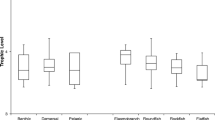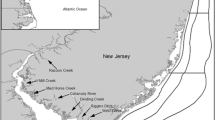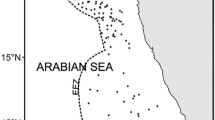Abstract
We examined the feeding ecology and niche segregation of the ten most abundant fish species caught by longline operations off eastern Australia between 1992 and 2006. Diets of 3,562 individuals were examined. Hook timer data were collected from a further 328 fish to examine feeding behaviour in relation to depth and time of day. Prey biomass was significantly related to predator species, predator length and year and latitude of capture. Although the fish examined fed on a mix of fish, squid and crustacea, fish dominated the diet of all species except small albacore (Thunnus alalunga) which fed mainly on crustacea and large swordfish (Xiphias gladius) and albacore which fed mainly on squid. Cannibalism was observed in lancetfish (Alepisaurus spp.). Multidimensional scaling identified three species groups based on their diet composition. One group consisted of yellowfin tuna (T. albacares), striped marlin (Tetrapturus audax) and dolphinfish (Coryphaena hippurus); a second group consisted of bigeye tuna (T. obesus), swordfish and albacore; and a third consisted of southern bluefin tuna (T. maccoyii) and blue shark (Prionace glauca). Of note was the separation of mako shark (Isurus oxyrhynchus) and lancetfish from all other predators. Prey length generally increased with increasing predator length although even large predators fed on a wide range of prey lengths including very small prey. Overall, differences in prey type and size, feeding times and depths were noted across the range of species examined to the extent that predators with overlapping prey, either in type or size, fed at different times of the diel period or at different depths. Taken together these data provide evidence for feeding niche segregation across the range of oceanic top predators examined.














Similar content being viewed by others
References
Bard FX, Kouamé B, Hervé A (2002) Schools of large yellowfin (Thunnus albacares) concentrated by foraging on a monospecific layer of Cubiceps pauciradiatus, observed in the eastern tropical Atlantic. Coll Vol Sci Pap ICCAT 54:33–41
Bernal D, Sepulveda C, Musyl M, Brill R (2009) The eco-physiology of swimming and movement patterns of tunas, billfishes and large pelagic sharks. In: Domenici P, Kapoor BG (eds) Fish locomotion—an etho-ecological approach. Science Publishers, Enfield
Bestley S, Patterson TA, Hindell MA, Gunn JS (2008) Feeding ecology of wild migratory tunas revealed by archival tag records of visceral warming. J Anim Ecol 77:1223–1233
Bethea DM, Buckel JA, Carlson JK (2004) Foraging ecology of the early life stages of four sympatric shark species. Mar Ecol Prog Ser 268:245–264
Bigelow KA, Boggs CH, He X (1999) Environmental effects on swordfish and blue shark catch rates in the US North Pacific longline fishery. Fish Oceanogr 8:178–198
Block BA, Keen JE, Castillo B, Dewar H, Freund EV, Marcinek DJ, Brill RW, Farwell C (1997) Environmental preferences of yellowfin tuna (Thunnus albacares) at the northern extent of its range. Mar Biol 130:119–132
Boggs CH (1992) Depth, capture time, and hooked longevity of longline-caught pelagic fish—timing bites of fish with chips. Fish Bull 90:642–658
Campbell RA, Hobday AJ (2003) Swordfish—Environment—Seamount—Fishery interactions off eastern Australia. Report to the Australian fisheries management authority, pp 1–97
Campbell RA, Young JW (2008) Determination of effective longline effort in the Eastern Tuna and Billfish fishery. Final report for project 2005/004, Fisheries Research and Development Corporation, Canberra
Chipps SR, Garvey JE (2007) Quantitative assessment of food habits and feeding patterns. In: Guy C, Brown M (eds) Analysis and interpretation of freshwater fisheries data, chap 11. American Fisheries Society, Bethesda, MD
Christensen JS, Moen AG, Hansen TH, Nilssen KT (2005) Digestion of capelin, Mallotus Villosus (Muller), herring, Clupea Harengus L., and polar cod, Boreogadus saida (Lepechin), otoliths in a simulated seal stomach. ICES J Mar Sci 62:86–92
Condie SA, Dunn JR (2006) A seasonal characteristics of the surface mixed layer in the Australasian region: implications for primary production regimes and biogeography. Mar Freshwat Res 57:569–590
Costello MJ (1990) Predator feeding strategy and prey importance: a new graphical analysis. J Fish Biol 36:261–263
Cox SP, Essington TE, Kitchell JF, Martell SJD, Walters CJ, Boggs C, Kaplan I (2002) Reconstructing ecosystem dynamics in the central Pacific Ocean, 1952–1998. II. A preliminary assessment of the trophic impacts of fishing and effects on tuna dynamics. Can J Fish Aquat Sci 59:1736–1747
Dambacher JM (2005) Analysis of AFMA observer data July 2004–June 2005. Report to the Eastern Tuna and Billfish fishery resource assessment group meeting, November 17–18, 2005
Dambacher JM, Young JW, Olson RJ, Allain V, Galván-Magaña F, Lansdell MJ, Bocanegra-Castillo N, Alatorre-Ramírez V, Cooper SP, Duffy LM (2010) Analyzing pelagic food webs leading to top predators in the Pacific Ocean: a graph-theoretic approach. Progr Oceanogr (in press)
Evans K, Langley A, Clear NP, Williams P, Patterson T, Sibert J, Hampton J, Gunn JS (2008) Behaviour and habitat preferences of bigeye tuna (Thunnus obesus) and their influence on longline fishery catches in the western Coral Sea. Can J Fish Aquat Sci 65:2427–2443
Farley J, Davis TLO (1997) Reproductive dynamics of southern bluefin tuna, Thunnus maccoyii. Fish Bull 96:223–236
Griffiths SP, Fry GC, Manson FJ, Pillans RD (2007) Feeding dynamics, consumption rates and daily ration of longtail tuna (Thunnus tonggol) in Australian waters, with emphasis on the consumption of commercially important prawns. Mar Freshwat Res 58:376–397
Griffiths SP, Young JW, Lansdell MJ, Campbell RA, Hampton J, Hoyle SD, Langley A, Bromhead D, Hinton MG (2010) Ecological effects of longline fishing and climate change on the pelagic ecosystem off eastern Australia. Rev Fish Biol Fish. doi:10.1007/s11160-009-9157-7
Grubbs RD, Holland KN, Itano DG (2006) Comparative trophic ecology of yellowfin and bigeye tuna associated with natural and man-made aggregation sites in Hawaiian waters. SCTB 15 Working paper. Standing Committee on Tuna and Billfish
Heithaus MR, Frid A, Wirsing AJ, Worm B (2008) Predicting ecological consequences of marine top predator declines. TREE 23:202–210
Hobday AJ, Stobutzki I, Webb H (2004) Draft ecological risk assessment for the effects of fishing: Eastern Tuna and Billfish Fishery (v7). In: Hobday AJ, Smith ADM, Stobutzki I (eds) Ecological risk assessment for Australian commonwealth fisheries. Final report–stage 1. Hazard identification and preliminary risk assessment. July 2004. Report to the Australian Fisheries Management Authority, Canberra, Australia
Jobling M, Breiby A (1986) The use and abuse of fish otoliths in studies of feeding habits of marine piscivores. Sarsia 71:265–274
Juanes F (1994) What determines prey size selectivity in piscivorous fishes? In: Stouder DJ, Fresh KL, Feller RJ (eds) Theory and application in fish feeding ecology. University of South Carolina Press, Columbia, South Carolina, pp 79–100
Juanes F (2003) The allometry of cannibalism in piscivorous fishes. Can J Fish Aquat Sci 60:594–602
Juanes F, Buckel JA, Scharf FS (2002) Feeding ecology of piscivorous fishes. In: Hart PJB, Reynolds JD (eds) The handbook of fish biology and fisheries, vol 1, Fish biology. Blackwell Scientific Publications, London, pp 267–283
Kirby D (2005) Prey consumption estimates for tunas in the WCPO. Working paper presented at the first regular session Noumea, New Caledonia 8–19 August 2005. Scientific Committee for the Commission for the Conservation and Management of Highly Migratory Fish Stocks in the Western and Central Pacific Ocean
Kitchell JF, Boggs CH, He X, Walters CJ (1999) Keystone predators in the Central Pacific. In: Ecosystem approaches for fisheries management, University of Alaska Sea Grant, AK-SG-99-01, Fairbanks, pp 665–683
Krebs CJ (1989) Ecological methodology. Harper Collins Publishers, New York
Lansdell MJ, Young JW (2007) Pelagic cephalopods from eastern Australia: species composition, horizontal and vertical distribution determined from the diets of pelagic fishes. Rev Fish Biol Fish 17:125–138
Ménard F, Stéquert B, Rubin A, Herrera M, Marchal E (2000) Food consumption of tuna in the Equatorial Atlantic ocean: FAD associated versus unassociated schools. Aquat Living Resour 13:233–240
Ménard F, Labrune C, Shin Y, Asine A, Bard F (2006) Opportunistic predation in tuna: a size-based approach. Mar Ecol Prog Ser 323:223–231
Ménard F, Lorrain A, Potier M, Marsac F (2007) Isotopic evidence of distinct feeding ecologies and movement patterns in two migratory predators (yellowfin tuna and swordfish) of the western Indian Ocean. Mar Biol 153:141–152
Olson RJ, Boggs CH (1986) Apex predation by yellowfin tuna (Thunnus albacares): independent estimates from gastric evacuation and stomach contents, bioenergetics, and Caesium concentrations. Can J Fish Aquat Sci 43:1760–1775
Olson RJ, Galvan-Magana F (2002) Food habits and consumption rates of common dolphinfish (Coryphaena hippurus) in the eastern Pacific Ocean. Fish Bull 100:279–298
Olson RJ, Mullen AJ (1986) Recent developments for making gastric evacuation and daily ration determinations. Environ Biol Fish 16:183–191
Parry M (2006) Feeding behaviour of two ommastrephid squids Ommastrephes bartramii and Sthenoteuthis oualaniensis off Hawaii. Mar Ecol Prog Ser 318:229–235
Pauly D, Christensen V (1995) Primary production required to sustain global fisheries. Nature 374:255–257
Potier M, Marsac F, Cherel Y, Lucas V, Sabatié R, Maury O, Ménard F (2007) Forage fauna in the diet of three large pelagic fishes (lancetfish, swordfish and yellowfin tuna) in the western equatorial Indian Ocean. Fish Res 83:60–72
Potier M, Romanov E, Cherel Y, Sabatié R, Zamorov V, Ménard F (2008) Spatial distribution of Cubiceps pauciradiatus (Perciformes: Nomeidae) in the tropical Indian Ocean and its importance in the diet of large pelagic fishes. Aquat Living Resour 21:123–134
Pusineri C, Chancollon O, Ringelstein J, Ridoux V (2008) Feeding niche segregation among the Northeast Atlantic community of oceanic top predators. Mar Ecol Prog Ser 361:21–34
Revill AT, Young JW, Lansdell MJ (2009) Stable isotopic evidence for trophic groupings and bio-regionalization of predators and their prey in oceanic waters off eastern Australia. Mar Biol 156:1241–1253
Ridgway KR, Godfrey JS (1997) Seasonal cycle of the East Australian Current. J Geophys Res 102:921–936
Romanov E, Ménard F, Zamorov VV, Potier M (2008) Variability in conspecific predation among longnose lancetfish Alepisaurus ferox in the western Indian Ocean. Fish Sci 74:62–68
Scharf FS, Juanes F, Sutherland M (1998) Inferring ecological relationships from the edges of scatter diagrams: comparison of regression techniques. Ecology 79:448–460
Scharf FS, Juanes F, Rountree RA (2000) Predator size-prey size relationships of marine fish predators: interspecific variation and effects of ontogeny and body size on trophic niche breadth. Mar Ecol Prog Ser 208:229–240
Sedberry GR, Loefer JK (2001) Satellite telemetry tracking of swordfish, Xiphias gladius, off the eastern United States. Mar Biol 139:355–360
Siegel S (1956) Non-parametric statistics for the behavioural sciences. McGraw-Hill, New York
Young JW, Jordan AR, Bobbi C, Johannes RE, Haskard K, Pullen G (1993) Seasonal and interannual variations in krill (Nyctiphanes australis) stocks and their relationship to the fishery for jack mackerel (Trachurus declivis) off eastern Tasmania, Australia. Mar Biol 116:9–18
Young JW, Lamb TD, Le D, Bradford RW, Whitelaw AW (1997) Feeding ecology and interannual variations in diet of southern bluefin tuna, Thunnus maccoyii, in relation to coastal and oceanic waters off eastern Tasmania, Australia. Environ Biol Fish 50:275–291
Young JW, Bradford RW, Clementson LA, Kloser RJ, Galea H (2001) Yellowfin tuna (Thunnus albacares) aggregations along the shelf break of southeastern Australia: links between inshore and offshore processes. Mar Freshwat Res 52:463–474
Young JW, Lansdell MJ, Riddoch S, Revill AT (2006) Feeding ecology of broadbill swordfish, Xiphias gladius (Linnaeus, 1758), off eastern Australia in relation to physical and environmental variables. Bull Mar Sci 79:793–811
Young JW, Lansdell MJ, Hobday AJ, Dambacher JM, Cooper SP, Kloser RJ, Griffiths SP, Nichols PD, Revill AT (2009) Determining ecosystem effects of longline fishing in the Eastern Tuna and Billfish Fishery. FRDC Final Report 2004/063. 335 pp
Young JW, Guest MA, Lansdell MJ, Phleger CF, Nichols PD (2010) Discrimination of prey species of juvenile swordfish Xiphias gladius (Linnaeus 1758) using signature fatty acid analyses. Progr Oceanogr. doi:10.1016/j.pocean.2010.04.028
Young JW, Hobday AJ, Kloser RJ, Bonham PI, Clementson LA, Campbell RA, Lansdell MJ (2010) The biological oceanography of the East Australian Current and surrounding waters in relation to tuna and billfish catches off eastern Australia. Deep Sea Res (in press)
Acknowledgments
This work was carried out as part of wider research programme on the trophodynamics of the Eastern Australian Tuna and Billfish fishery and was funded by a grant from the Fisheries Research and Development Corporation (FRDC Grant 63/2004). The hook timer data were funded separately by a grant to R. A. Campbell and J. W. Young, also by FRDC (FRDC Grant 04/2005). We would like to thank the skippers of the Eastern Tuna and Billfish fishery, Australian Fisheries Management Authority observers, Keller Kopf (Charles Sturt University) and members of the CSIRO Pelagic Fisheries and Ecosystem team for help in collecting samples. We are grateful for the constructive comments of the reviewers and the editor. This manuscript benefited greatly from the interactions provided by the lead author’s involvement with CLIOTOP Working Group 3.
Author information
Authors and Affiliations
Corresponding author
Additional information
Communicated by M. A. Peck.
Rights and permissions
About this article
Cite this article
Young, J.W., Lansdell, M.J., Campbell, R.A. et al. Feeding ecology and niche segregation in oceanic top predators off eastern Australia. Mar Biol 157, 2347–2368 (2010). https://doi.org/10.1007/s00227-010-1500-y
Received:
Accepted:
Published:
Issue Date:
DOI: https://doi.org/10.1007/s00227-010-1500-y




